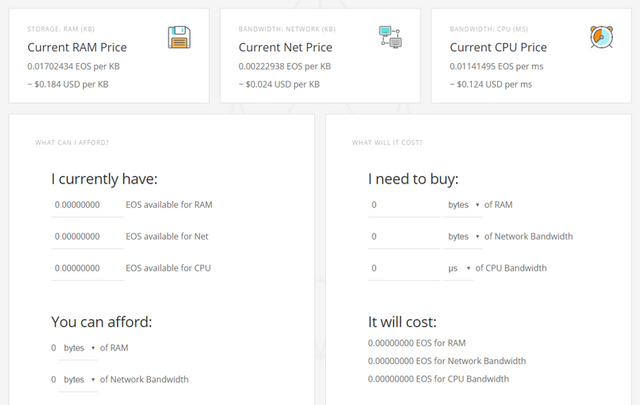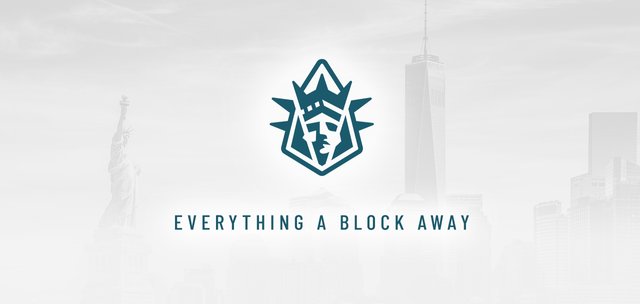Calculating the Costs of Resources on EOS: The EOS Resource Planner is Live!

EOSrp.io Site Link
Simple + Scalable == Powerful
EOS New York believes in building simple and scalable solutions. There are many fundamental tools that don't exist yet that are needed. Block Producers should remember this when prioritizing labor and resources.
Three months ago we started working on the EOS Resource Planner and, now that the network is live, we've finished our MVP which can be found at https://www.eosrp.io/.
The EOS Resource Planner

What is the EOS Resource Planner? It's an open source tool that answers very simple questions that every developer is going to be asking.
- What can I afford on the network with the tokens I have?
- How many tokens do I need to afford this amount of resources?
What Does This All Mean?
Let's walk through each resource.
What is RAM?
RAM, is quick read/write access to a storage device. It's required to store data on the blockchain and must be purchased. Utilizing the Bancor algorithm, the price of RAM is set by the EOSIO software and automatically adjusts up and down based on supply and demand. A 0.5% fee is applied to each sale and purchase of RAM and these funds are sent to the Worker Proposal Fund.
What is Network Bandwidth?
Network Bandwidth is the average rate of successful data transfer through a communication path. It is measured as a rolling average of consumption in bytes over the last 3 days. Your network bandwidth used accumulates each time you send an action or transaction and slowly decreases when not being used. The more tokens you stake for net bandwidth the more you get to use. You can unstake at any time to reclaim your EOS tokens. No fee is applied and all EOS tokens are returned to the user.
What is CPU Bandwidth?
CPU Bandwidth is the rate at which data can be read from a storage device. It's measured as the average of consumption in microseconds over the last 3 days. CPU bandwidth used accumulates each time you send an action or transaction and slowly decreases when not being used. The longer your transaction runs i.e. the more complicated it is, the more CPU bandwidth it will consume. You can unstake at any time to reclaim your EOS tokens. No fee is applied and all EOS tokens are returned to the user.
Roadmap of Future Features
- Historical charting of metrics (resource costs, RAM utilization)
- Exact RAM cost calculation using the Bancor algorithm
- Benchmarking of common actions like creating an account
- Predictive estimates of future resource prices
- Paste contract code in to get the exact cost to deploy/run actions against it
- Average Chintai pricing (when available)
- Storage pricing (when available)
Please submit your suggestions here. EOS New York will follow up with a how-to which will detail how you can import the widgets we've created into your own site.

EOS New York is a Top 21 Block Producer on the EOS Mainnet Blockchain
I've said it before, as soon as us non techy people get wallet stuff safely figured out, you guys are among the first people I will vote for, and tell others to consider doing the same and why.
Your activity and resources are just great.
Thank you.
Thank you for the support!
It is my pleasure. You guys have done so much.
I sold off a lot of my stake here for EOS.
I've been in the Top 0.05% of bloggers here most of the last 18 mths in many categories.
I have a loyalty to Dan Larimer and publicly admit that with pride.
It's not really paying for resources, but rather temporarily staking EOS tokens in order to use them, isn't it? So it's like you need to deposit some money to pay for resources and get them back when resources no longer needed? Sounds pretty attractive to me if that's the case.
Exactly. The only caveat is that the price of eos can fluctuate while staked so the value may not be the same should you need to unstake and sell for whatever reason.
True, but still, even if price goes down then you get something back (or you may even get more back than you put in the first place if the price goes up). In the traditional world you pay fees for resources and these are in no way refundable :)
Good info, but my question is this: If I buy ram to run a smart contract, can I delete the contract at a future date and then reclaim and sell my ram?
Yes, you can.
I've been thinking of a project for the blockchain that uses EOS network nodes to monitor time changes for accurate time zone info. Right now the Olson tz database is the largest online solution for correct time keeping based upon IP addresses and zone names, but the process of submitting changes is manual and sometimes after the fact of a time change standard. This blockchain would be able to monitor the actual standards used based upon location and make corrections based upon consensus.
Authority typically makes these decrees now which leaves coders with the mess of updating their software. I think this blockchain might be able to make updates more automatic.
Plus that other stuff you mentioned to me a few days ago @zoidsoft
(:
Is there a tool that will estimate the amount of network resources it will take to run a group of smart contracts?
That would need to be calculated by you, the developer.
Upvote this for me please? https://steemit.com/christianity/@bible.com/verse-of-the-day-hebrews-4-16-nlt